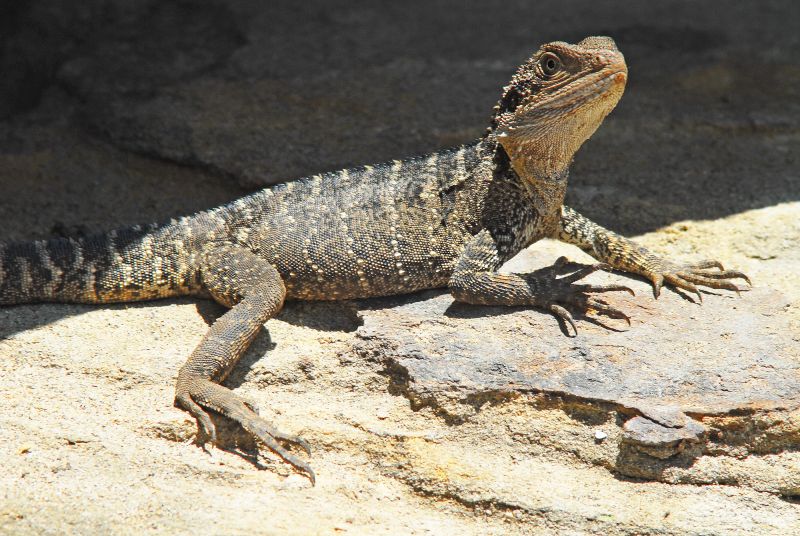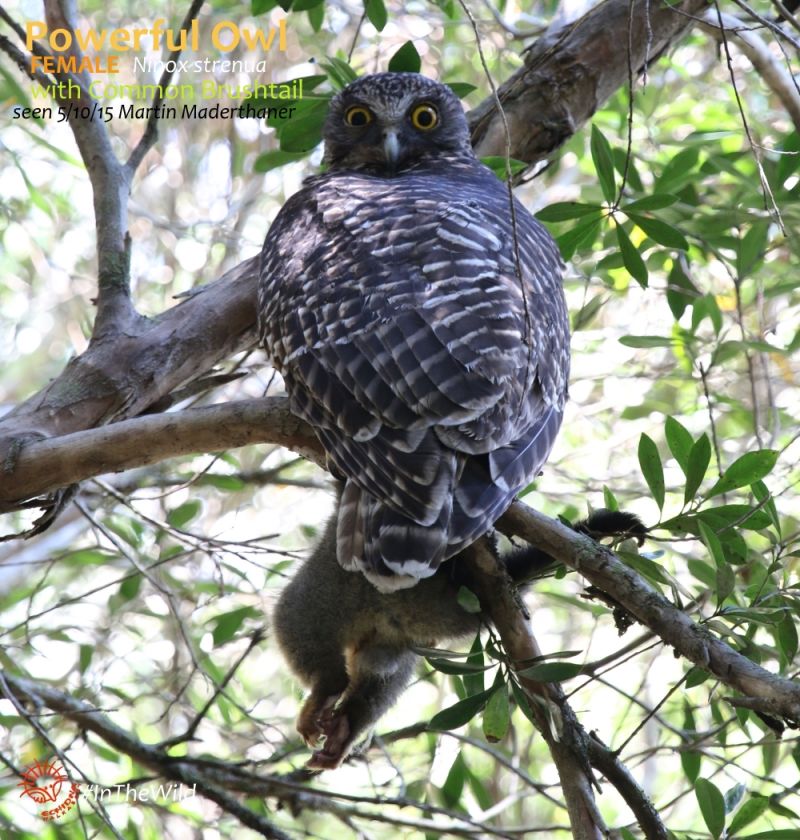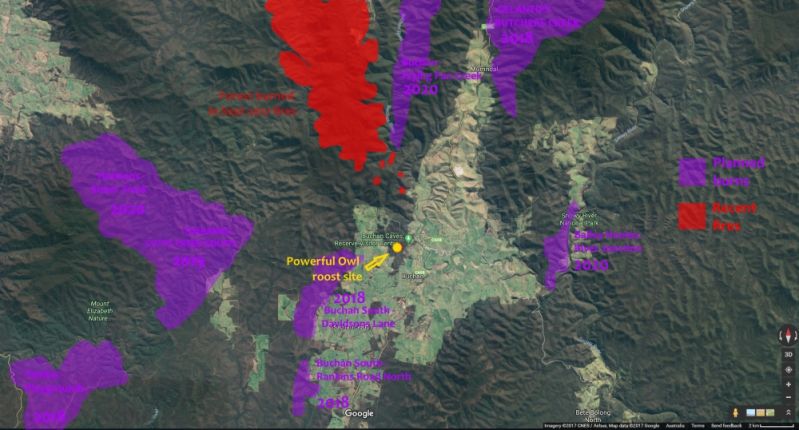In February 2014 a bushfire ripped through Raymond Creek Falls in the Snowy River National Park, East Gippsland. This area was a highlight of our 4 day Wildlife Journey to East Gippsland and had shown great promise as a birdwatching site – the combination of dry Brittle Gum heathy woodland and wet Peppermint & Mountain Grey Gum forest drew in different birds with each season. I saw White-bellied Cuckoo-shrike, Rufous Songlarks, Flame and Scarlet Robins, large numbers of honeyeaters and once, Turquoise Parrots. We will never know if the Turquoise Parrots survived the fire as they have not been recorded there since, but other species are back.
Sadly, we had to find a new place to visit the Snowy River. International travellers don’t come to Australia to see burnt forest, and National Parks are closed for up to a year after such fires. The new site had to be close to our base at Snowy River Homestead Orbost, accessible, diverse and rich in wildlife. We looked to Buchan, and we found Powerful Owls.

Gippsland Water Dragon
Though the public part of Buchan Caves Reserve is highly-modified, around three-quarters of the park is natural bush that supports a lot of wildlife. Eastern Grey Kangaroos graze the lawns around the tents, Swamp Wallabies are seen in the forest, Koalas are seen along the Orbost-Buchan Rd, at Murrindal, and sometimes in the reserve. A Platypus is occasionally seen at Murrindal too. Echidna, Lace Monitor/Goanna, the beautiful Copper-tailed Skink, Gippsland Water Dragon are all seen frequently. We’re not there at night, but we know that Common Brushtail and Sugar Glider are found in the area too – because the Powerful Owls of Buchan prey on them.
Significant Sightings
- On 7 April 2014, on one of our first visits, the office staff at the Caves visitor centre mentioned that someone had seen a Powerful Owl on the Spring Creek Walk. Guide Martin Maderthaner walked into Spring Creek and found a female owl roosting in a Kanooka tree (Tristaniopsis laurina).
- On 24 November 2014 at 2.24pm Guide Roger Smith found a female owl holding a partially-eaten, headless, light grey animal that he assumed was a brushtail. On closer inspection of the photo, we are now convinced it was a small koala.
- On 9 March 2015 at 2.45pm Guide Martin found a female owl holding a Common Brushtail, then again on 5 October 2015 Martin found the female roosting with another Common Brushtail.


- Over 2017 we have run 10 trips into Spring Creek in Buchan, and the owls have been seen on five visits, which is quite a high success rate for this species.
- On 8 May 2017 Martin and new Guide Brett Howell were running the tour together. At 10.50am Brett found the female holding a perfectly-intact male Sugar Glider. The glider didn’t look at all damaged, in fact one could even have thought he was still alive except that he was totally immobile. This raises the question – was he caught close to dawn? Or do the owls wait some time before feeding on their prey?

- In late September 2017 a large fire burnt 8000 hectares north-west of the Buchan Caves Reserve. The closest point of the main fire was about 4km from the owls’ roosting site, with some spot fires closer still. We don’t know the home range of these owls, but McNabb (1) shows a Powerful Owl home range in good quality habitat of 300 hectares and Soderquist (2) shows home ranges of 1380 to 4770ha. With the lack of forest to their south-east, there is a good chance that some of their foraging area was affected by this fire. It could be critical for these birds that the remaining forest is protected from fire for some years.
- Our early October 2017 trip was prevented from accessing the site which was still closed due to the fire. To our relief, on 23rd October 2017 Martin found the female Powerful Owl roosting in a Kanooka holding an Australian Magpie.
- On 30 October 2017 at 10.00am Brett found the female roosting quite low, just above the track. The group watched her for a while, and after a few minutes she flew off, low, straight over their heads and perched again on a higher branch about 20metres away. Brett feels there was no attempt by her to terrorise them, she simply chose the straightest route to a higher branch, which happened to be over their heads. All this time two Swamp Wallabies were fighting nearby, completely focussed on each other. Brett and guests all agreed it was the best day ever and couldn’t be topped. Then they walked along the gully and found the male Powerful Owl!
- On 27 November 2017 Martin found a female bird. Further along the creek, near the falls, they watched a Restless Flycatcher bravely tormenting a much-larger Pied Currawong. As they watched the currawong flew away from the determined flycatcher, right towards the well-hidden male Powerful Owl. This pulled the currawong up short! Priorities changed rapidly, and the currawong immediately started harassing the owl. The male owl ignored the currawong completely.
Fragility of Existence
The Powerful Owls of Buchan seem to be doing well, but we have not seen any evidence of breeding. If they had bred successfully this year, young should have been present or near an adult from August to now (and up to January 2018). It is possible that the young were with the male, who was not found on 23 October or 13 November, but as both male and female were found on 30 October and 27 November with no young, it might be assumed that they did not breed.
When I started to write this story the Powerful Owls of Buchan were a nice sighting that I felt should be shared with other nature lovers. I now see how fragile their existence is – they have huge home ranges, require abundant arboreal mammal prey and large old hollow-bearing trees to breed. I find myself checking the planned burns and logging for the area, and I’m concerned (see figures below). There are fuel reduction burns planned in their habitat in the next two years. Have the owls been taken into account, and do all these burns need to proceed?

Above: Red areas denote recent fires and purple areas denote prescribed burn offs.

A bushfire started our relationship with the Powerful Owls of Buchan. I don’t want our relationship ended by another fire. There is also logging planned in their habitat in the next three to five years. Has the combination of logging, planned burns and wildfires been considered for its total impact on the owls?
POSTSCRIPT:
This story shows the importance of recording observations and the potential value of the tourism industry to conservation – read here about how tour guides (and members of the public) can submit sightings for the benefit of science and conservation.
Help us support conservation in the region by travelling with us on our 4 day Wildlife Journey through East Gippsland.


